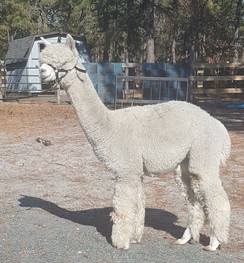|
Monday, June 5, 2017

Well, it is now June (please, please tell Mother Nature, if you have her ear, as I am tired of wearing a winter jacket to do my barn chores), which means breeding season is upon us here at Hidden Hill Farm Alpacas. Ideally, by now I would have submitted all my fiber samples so that I can assess the 2016 cria crop but, being a fleece sorter, I know a lot already. Regardless, statistics can give us a great deal more with which to evaluate animals.
On shearing day, I collect that prime blanket fleece as it comes off each animal and, even if I had someone to do it for me, I think I would prefer to be there. You might ask why. Well, I can see a great deal about fleeces, not only on my young animals but on my mature foundation stock, just by how that fleece comes off. Is it in one solid piece regardless of how the shearer's "head guy" turns that animal, is staple length hanging in there, is pulling a fleece sample more difficult or does the sample just fall out in one's hand? Are there extending primaries? I have scored my animals on this basis, in addition to the more holistic scoring system I employ, and it is telling indeed. In fact, some of my best foundation females whose fleeces still exhibit all the qualities I would seek in a young prospective foundation female, are over ten years old! Yes, you read that right. Now, I probably have five or six females that I have bought that are in my foundation herd, and the rest were produced from my program.
Every breeding here is carefully calculated. I want to know that what I produce will be a keeper. Is it all the harder to sell those keepers? Well, yes, it is, to a degree. Selling one's best is not easy! I am going to be asking the potential buyer many questions about how they plan to use those animals. After all, these could be the future of one's herd, if all the homework one puts into the task of ferreting out the traits of each female and selecting just the right male to enhance that trait or traits (only if they are highly correlated can you even consider trying for multiple trait improvements) that you have selected as well as allowing that female's best qualities to be fully expressed. I have about forty elements by which I score an animal and, since I do herd evaluations for other breeders, I finally had to codify those elements, so I actually have a spreadsheet I can employ. Having bred alpacas for twenty years now, it is quite a simple matter to process a great many elements mentally when evaluating one's own females, and the process is so swift that it takes time to slow down and consider what the variables are that one is seeking. Now, I know there are people that use one male over an entire herd. That is fine, but my question to those that do this is: what are your chief complaints about the females in your herd? Are they all focused in one particular trait, or is there a fairly decent litany of things you would like to see in each, all of which vary by the female in question? If so, I would contend that there is no silver bullet male that can "fix" everything in such a herd. If that male were to make a substantial improvement on 15% of that variable herd, I would say you have quite a male on your hands! Now, if you are employing a traditional livestock model and are willing to wait for generations of offspring, then using a "herdsire" (which is a term that really only ought to be used when you are putting that male over all of your females) may be the way to go. With a little over thirty breeding age females here, I breed fifteen to twenty per year. I consider myself to be a trait breeder for that reason -- and for the reason that I breed for keeps, regardless of whether or not I sell an animal.
Truthfully, I have very few traits that I am honed in on, even among my thirty or so females. I consider some to have far more "advanced" fleeces and some of these also seem to hold onto desirable fleece characteristics longer than others. I take note of any pedigree correlations when I make my notes from shearing day. However, this is the extent to which variability plays a role in my program.
Well, I never know when I am going to sit down and write a blog for my website. I guess today was one of those days.
|